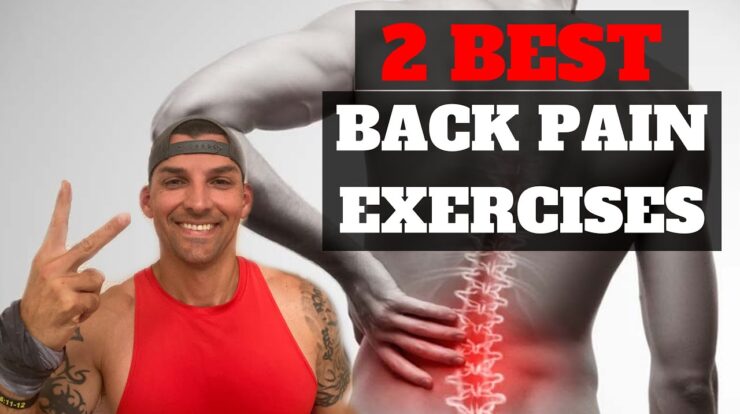
Exercises to relieve lower back pain can be an effective way to manage and alleviate discomfort. Understanding the causes and impact of lower back pain is crucial, and this guide provides a comprehensive list of exercises, stretches, and lifestyle modifications to help alleviate it.
Lower back pain is a common issue that can significantly affect daily life. This guide aims to empower individuals with knowledge and practical strategies to address lower back pain effectively.
Understanding Lower Back Pain

Lower back pain is a common condition that can affect people of all ages. It can be caused by a variety of factors, including:* Muscle strains
- Ligament sprains
- Herniated discs
- Arthritis
- Spinal stenosis
Lower back pain can cause a range of symptoms, including:* Pain in the lower back
- Stiffness
- Muscle spasms
- Numbness or tingling
- Weakness
Lower back pain can have a significant impact on daily life, making it difficult to work, exercise, and even sleep.
Studies have shown that strengthening back muscles can improve posture, reduce pain, and prevent injuries. In fact, a strong back can also contribute to a healthy spine and overall well-being.
Exercises for Relieving Lower Back Pain
There are a number of exercises that can help to relieve lower back pain. These exercises can help to strengthen the muscles around the lower back, improve flexibility, and reduce pain.Some of the most effective exercises for relieving lower back pain include:* Pelvic tilts
- Knee-to-chest stretches
- Hamstring stretches
- Quad stretches
- Glute bridges
- Planks
- Side planks
- Bird dogs
- Superman
- Cat-cow
These exercises can be done at home or in a gym. It is important to start slowly and gradually increase the intensity and duration of your workouts over time.
Stretching and Flexibility for Lower Back Pain
Stretching and flexibility are important for managing lower back pain. Stretching can help to improve range of motion, reduce tension, and alleviate pain.Some of the most effective stretches for lower back pain include:* Child’s pose
- Cat-cow stretch
- Hamstring stretch
- Quad stretch
- Glute stretch
- Piriformis stretch
- IT band stretch
These stretches can be done at home or in a gym. It is important to hold each stretch for 30 seconds to 60 seconds.
Core Strengthening Exercises for Lower Back Pain, Exercises to relieve lower back pain
The core muscles play an important role in supporting the lower back. Strengthening the core muscles can help to improve stability and reduce back pain.Some of the most effective core strengthening exercises for lower back pain include:* Planks
- Side planks
- Bird dogs
- Superman
- Russian twists
- Leg raises
- Toe taps
These exercises can be done at home or in a gym. It is important to start slowly and gradually increase the intensity and duration of your workouts over time.
In German, the traditional way to say “Happy Mother’s Day” is “Alles Gute zum Muttertag”. However, there are many other ways to express your love and gratitude in German .
Other Non-Exercise Therapies for Lower Back Pain
In addition to exercise, there are a number of other non-exercise therapies that can help to relieve lower back pain. These therapies include:* Massage
If you’re wondering whether or not to say “Happy Mother’s Day” to a pregnant woman, the answer is yes! Even though she may not have given birth yet, she is still a mother-to-be and deserves to be celebrated. In fact, some people believe that it’s especially important to acknowledge pregnant women on Mother’s Day, as it’s a way to show them that you’re thinking of them and their future child.
- Acupuncture
- Heat therapy
- Cold therapy
- Electrical stimulation
- Ultrasound
These therapies can help to reduce inflammation, improve circulation, and promote relaxation.
Lifestyle Modifications for Lower Back Pain Management
There are a number of lifestyle modifications that can help to alleviate lower back pain. These modifications include:* Maintaining a healthy weight
- Improving posture
- Avoiding prolonged sitting or standing
- Wearing comfortable shoes
- Using a supportive mattress and pillow
- Getting regular exercise
- Quitting smoking
These modifications can help to reduce strain on the lower back and improve overall well-being.
When to Seek Medical Attention for Lower Back Pain
If your lower back pain is severe or does not improve with home treatment, it is important to seek medical attention. You should also seek medical attention if you experience any of the following symptoms:* Numbness or tingling in the legs or feet
Today is Mother’s Day, a day to celebrate the love and sacrifices of mothers everywhere. In Vietnamese, the traditional way to say “Happy Mother’s Day” is “Chúc mừng Ngày của Mẹ”. Many people also choose to express their love and gratitude in Vietnamese .
- Weakness in the legs or feet
- Loss of bowel or bladder control
- Fever
- Chills
- Night sweats
These symptoms may indicate a serious underlying condition that requires medical treatment.
Final Wrap-Up

By incorporating these exercises and lifestyle changes into your routine, you can improve flexibility, strengthen core muscles, and reduce strain on the lower back. Remember, it’s essential to seek medical attention if pain persists or worsens to rule out any underlying medical conditions.
If you’re looking for the perfect words to express your love and appreciation for your mother, check out these heartfelt wishes . They’re sure to make her feel special on her special day.
Take control of your lower back pain and embark on a journey towards improved mobility and well-being.
Answers to Common Questions: Exercises To Relieve Lower Back Pain
How often should I perform these exercises?
Aim to perform the exercises daily or every other day, gradually increasing the frequency as your pain improves.
Is it safe to do these exercises if I have a herniated disc?
Consult a healthcare professional before performing any exercises if you have a herniated disc or other underlying medical conditions.
Can I modify the exercises if they are too challenging?
Yes, the guide provides modifications for different fitness levels. Start with easier variations and gradually progress to more challenging ones.





